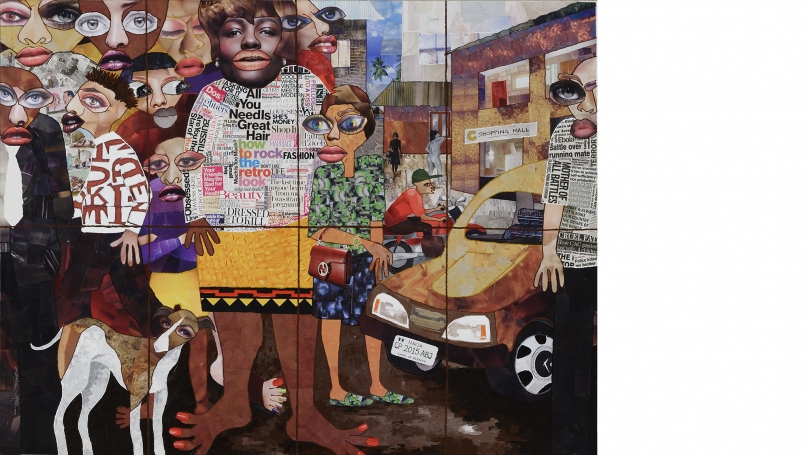Chike Obeagu is known for his expressive mixed-media paintings that explore social experiences of the everyday. City Scape and City Dwellers II represents his most successful attempt to date to push the formal and conceptual boundaries of his subject matter, the materiality of his medium, and photo-collage technique. Obeagu presents a condensed yet an all-encompassing view of Abuja, Nigeria's capital city, where he is based. The city serves as a microcosm of contemporary quotidian experience in Nigeria, as well as elsewhere in Africa and the world at large. Working with bright colors interspersed with cool colors, he captures the bustling energy of city life, people, animals, and coconstitutive elements of the urban environment, such as cars, motorcycles, and shopping malls. In the painting, the viewer encounters the various shades of people that populate the city: the working-class, the fashion-savvy, the mentally deranged, and the commercial motorcyclist, popularly called okada, as they move about their daily grind. Obeagu's photo-collage technique allows him to introduce textual elements that convey some of the recent events in Nigeria, such as electioneering campaigns and the recent Ebola outbreak. In this way, the painting is both a work of art and a visual record of the social milieu in Nigeria at a particular juncture.
Obeagu received his BA and MFA in painting from the University of Nigeria, Nsukka, in 1998 and 2003, respectively. He presently teaches painting and mixed media at the Department of Visual and Creative Arts, Federal University Lafia, Nassarawa State, Nigeria. He developed his photo-collage technique in his final year in art school when the lack of resources and financial means pushed him to seek cheap and easily accessible materials. This technique involves a seamless melding of colorful magazine and billboard poster cutouts and acrylic or oil paints, such that it is not always easy to tell where paper meets paint. In his compositions, he creates depth by carefully playing with scale, perception, and color. He achieves an embossed effect by using thick slabs of acrylic paint or polymer glue to outline figural elements and built structures, and to break the picture surface into grids or panels. Obeagu's works are often configured as narratives that reflect cultural, social, political, and economic concerns, and are at times laced with humor. His interest in everyday experiences includes both the banal and the poignant. His themes range from human interaction, music, religion, prostitutes on street corners, love and relationships, arsonists, and highway robbers, to historical events such as colonialism and the advent of Christianity in Nigeria.
Obeagu shares a creative affinity with artists such as South African Kay Hassan and Kenyan Wangechi Mutu. Hassan creates large-scale collages from scavenged billboard advertisement posters. Referred to as paper constructions, the collages take the form of portraits of ordinary people he encounters around the city of Johannesburg, South Africa's economic nerve center. Mutu, on the other hand, creates surreal collages (composed mainly of paint and cutouts) that often consist of figural forms with exaggerated features. She addresses a broad range of themes, including the urban social experiences in Nairobi, Kenya, her city of birth, and New York, where she is currently based. Obeagu's figural forms have similarly exaggerated features. His depictions of eyes and ears appear engorged, adding a surreal dimension to his compositions, as is the case in City Scape and City Dwellers II.
Related Exhibitions
